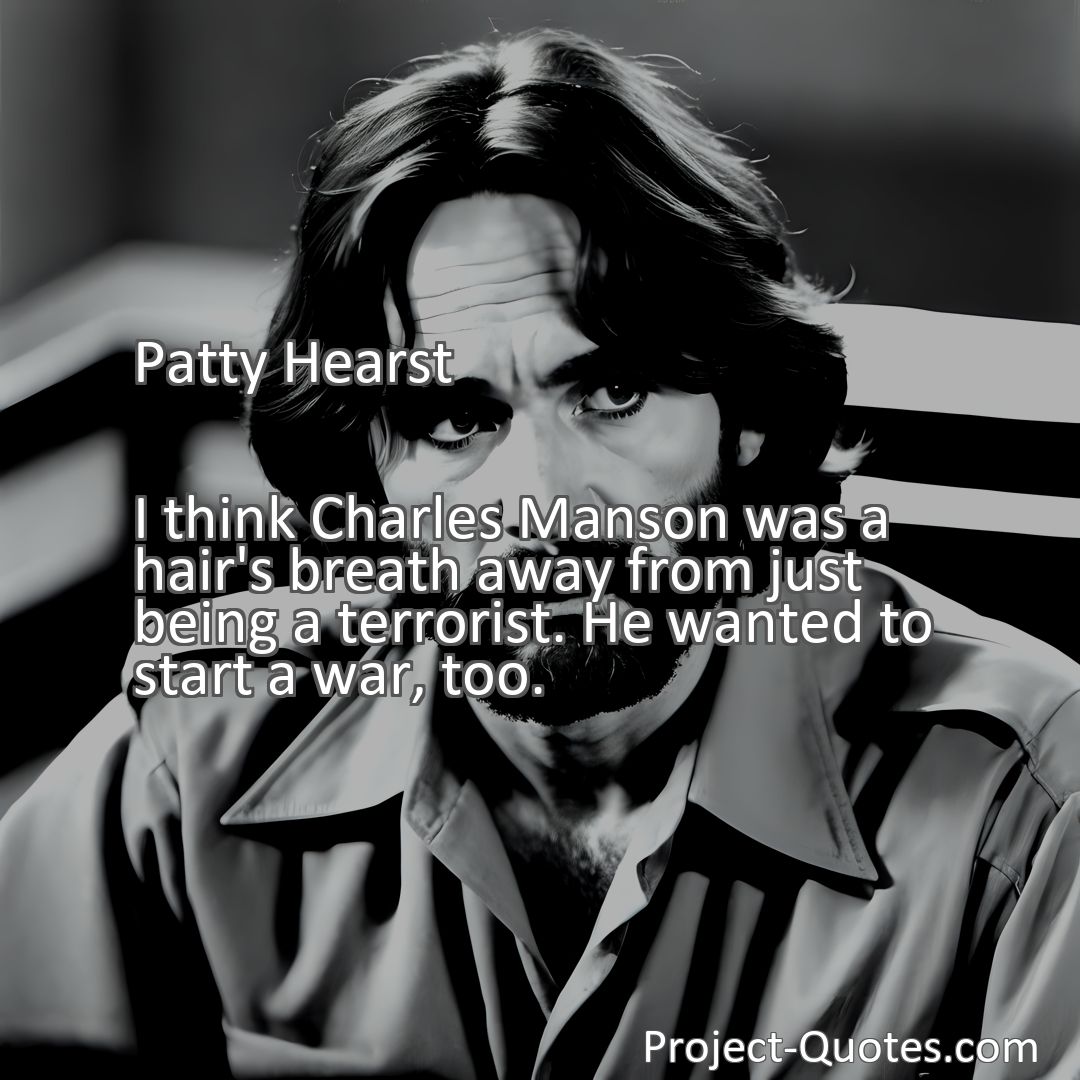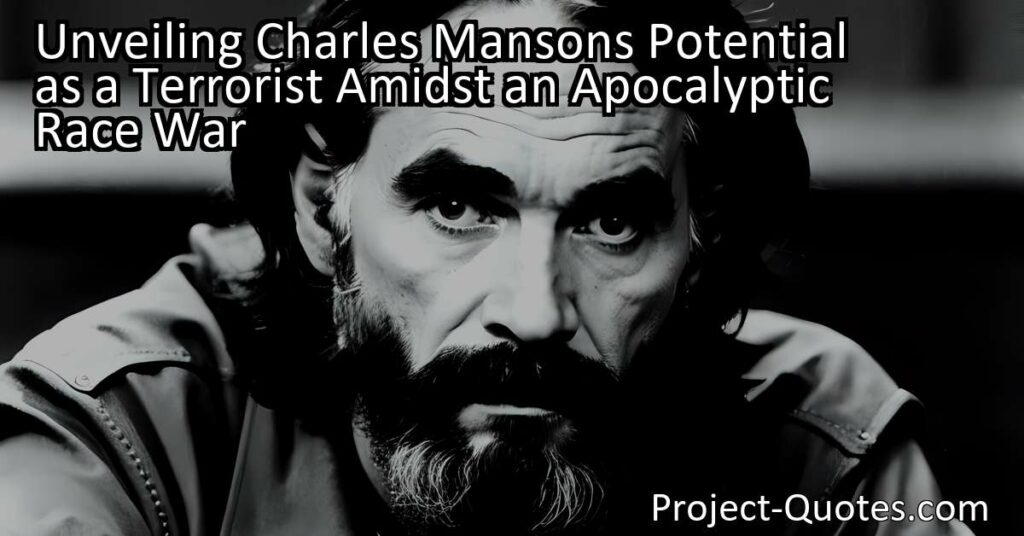I think Charles Manson was a hair’s breath away from just being a terrorist. He wanted to start a war, too.
Patty Hearst
Unveiling Charles Manson’s Potential as a Terrorist Amidst an Apocalyptic Race War This engaging summary explores Charles Manson’s potential as a terrorist and his desire to ignite an apocalyptic race war. While not fitting the traditional mold of a terrorist, Manson’s actions, such as targeting civilians and aiming to destabilize society, align with the characteristics typically associated with terrorism. Analyzing his motivations and actions provides valuable insights into the complex nature of terrorism and its profound impact on society.
Table of Contents
Meaning of Quote – I think Charles Manson was a hair’s breath away from just being a terrorist. He wanted to start a war, too.
In her famous quote, Patty Hearst opens up a thought-provoking discussion about Charles Manson and his potential categorization as a terrorist. Hearst, known for her own experiences with radicalism and being held captive by the Symbionese Liberation Army, provides a unique perspective on Manson’s intentions and his dangerous desire to incite violence. While Hearst merely suggests that Manson was “a hair’s breath away from just being a terrorist,” it is worth exploring whether his actions and ideology align with the characteristics typically associated with terrorism.
To truly understand Charles Manson’s place in history and the potential terrorism label that Hearst hints at, it is essential to delve into the details of his life and crimes. Born on November 12, 1934, in Cincinnati, Ohio, Manson faced a troubled childhood from the start. Raised without a stable family environment, he embarked on a life of crime from an early age. Throughout his adolescence and adult life, Manson spent a significant portion of his time behind bars, serving multiple sentences for offenses such as burglary, theft, and federal probation violations.
However, it was Manson’s creation of the Manson Family, a cult-like commune that followed his command, which propelled him into the public eye and solidified his place in history. Under his charismatic influence, Manson and his followers engaged in a series of heinous crimes, most notably the Tate-LaBianca murders in 1969. These brutal slayings shocked the nation, heralding the end of the ’60s counterculture era and forever linking Manson’s name to madness and evil.
What makes Manson particularly intriguing in relation to the terrorism debate is his desire to spark a race war, which he termed “Helter Skelter.” Manson believed that by orchestrating these gruesome murders and pinning the blame on African Americans, he could ignite a violent conflict between races. In his twisted worldview, this apocalyptic race war would eventually lead to the rise of the Manson Family as the dominant group, who would eventually rule over the chaos and destruction. This overarching aim to incite widespread violence for political and religious purposes indeed shares some similarities with acts commonly considered terrorism.
One key element of terrorism is the deliberate targeting of civilians to create fear and further a specific agenda. While Manson’s primary targets were the wealthy and influential, his actions undeniably terrified Los Angeles and the nation as a whole. The senseless and calculated nature of the murders sent shockwaves throughout society, evoking heightened levels of fear and mistrust. Families were no longer safe, and the Manson Family’s gruesome acts shook the belief in the sanctity of one’s own home.
Furthermore, the political motivation behind Manson’s actions aligns with one of the main goals of terrorism: to achieve change or further a specific cause. Through inspiring chaos and racial tension, Manson aimed to dismantle the existing societal order and implement his twisted vision. By this definition, his intentions bear striking resemblance to those of a terrorist. Instead of attacking physical infrastructures, Manson sought to destabilize society by sowing fear and mistrust among its members. His ultimate goal was to push society into anarchy and subsequently position himself as a leader amidst the ensuing chaos.
While Charles Manson’s actions and motivations display definite elements in line with terrorism, it is important to note some key distinctions as well. Terrorism is typically associated with political or ideological motivations, and Manson’s warped vision of Helter Skelter certainly falls within this realm. However, his methods differed from traditional terrorist tactics, which often involve bombings, hijackings, or other large-scale acts of violence. Manson relied on a small group of devoted followers and employed manipulation, indoctrination, and psychological coercion to carry out his crimes. Although his actions did not fit the conventional mold of terrorism, the underlying goals and strategies bear resemblances to the tactics employed by extremist groups seeking to incite fear and chaos.
Another aspect to consider is the absence of an organized network or explicit political agenda. While Hearst suggests that Manson was nearly a terrorist, it is crucial to acknowledge that his control extended primarily to his immediate followers. Unlike established terrorist organizations with a hierarchical structure, Manson’s influence remained confined within his cult-like commune. This distinction raises a question: can an individual, operating independently of an organization, fully be considered a terrorist? Manson’s ability to command his followers and orchestrate a series of horrific crimes showcases his deeply sinister nature, but it also sets him apart from the organized networks typically associated with terrorism.
In conclusion, Patty Hearst’s thought-provoking quote raises important questions about Charles Manson’s potential classification as a terrorist. While he may have fallen just short of fully fitting the mold of a traditional terrorist, Manson’s actions bear striking resemblances to the characteristics typically attributed to terrorism. His aim to incite a race war by targeting civilians and destabilizing society aligns with the goals of terrorism, even if his methods and structure differ. Manson’s twisted ideology and obsession with power ultimately led to the loss of innocent lives and left an indelible mark on history. By analyzing his motivations and actions, we can gain valuable insights into the complex nature of terrorism and the profound impact it has on society.
I hope this quote inspired image brings you hope and peace. Share it with someone who needs it today!


